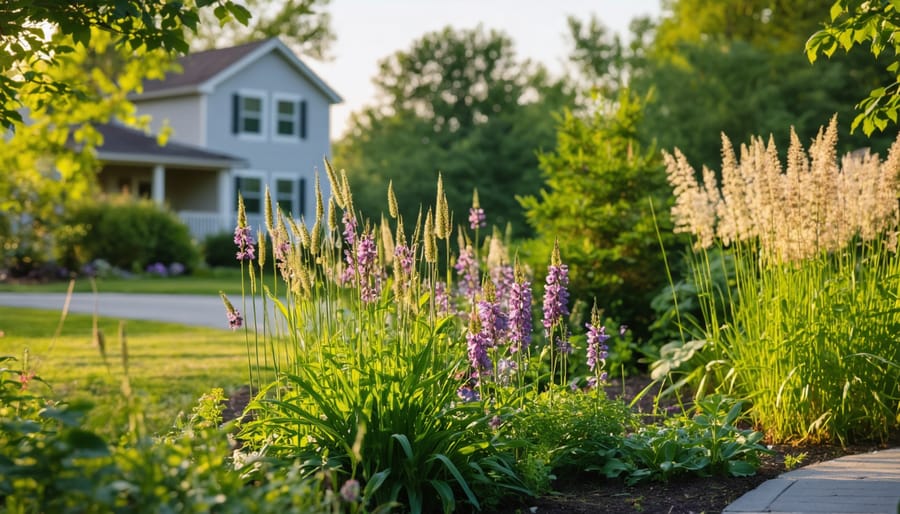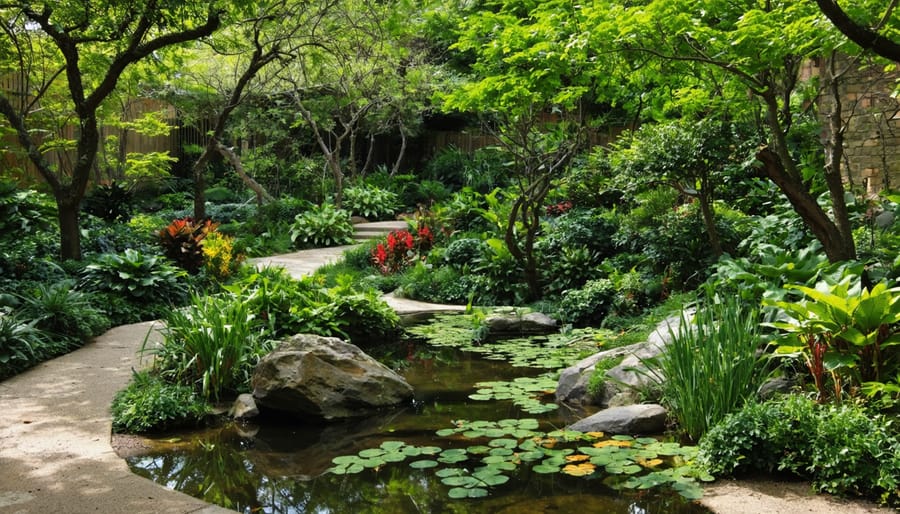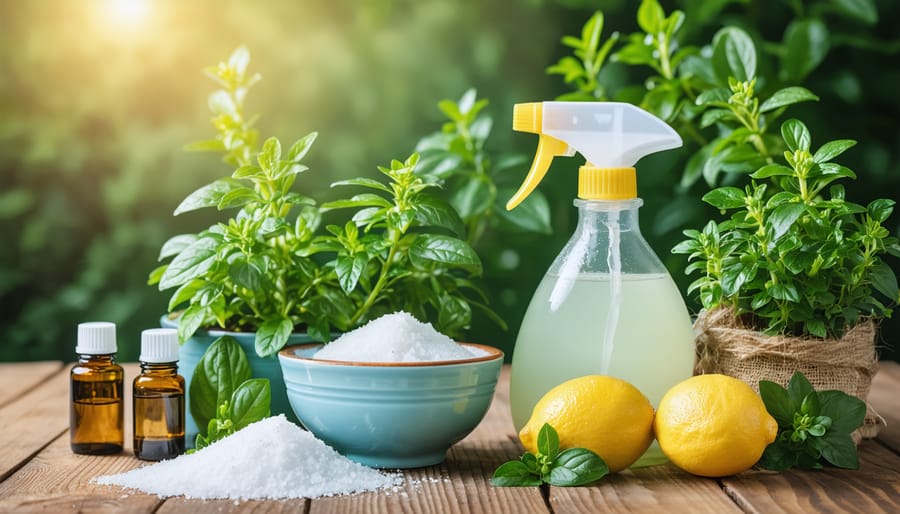Group native plants according to their natural habitats—woodland species with woodland companions, prairie plants with prairie partners—and you’ll create self-sustaining communities that practically care for themselves. These partnerships evolved over thousands of years, meaning the plants already know how to support each other without your constant intervention.
Native plant communities transform maintenance from a weekly battle into an occasional check-in. Instead of fighting nature with fertilizers, pesticides, and endless weeding, you’re working alongside it. The secret lies in mimicking what already thrives in your local wild spaces. When you plant a community rather than a collection, the deep-rooted prairie grasses hold soil while shorter wildflowers fill gaps where weeds might sneak in. Woodland groundcovers spread beneath taller shrubs, creating living mulch that suppresses invaders naturally.
The reduction in maintenance isn’t magic—it’s ecology at work. Native communities develop layered root systems that outcompete weeds, require zero fertilizer once established, and resist local pests without chemicals. You’ll spend less time mowing, watering, and spraying, and more time simply enjoying your garden.
This approach works whether you’re converting a small corner or an entire yard. The key is understanding which plants naturally grow together in your region, then recreating those partnerships in your own landscape. Once established, these communities don’t just maintain themselves—they actively improve your soil, support local wildlife, and become more resilient with each passing season.
What Native Plant Communities Actually Are (And Why They Matter)
How Plants Naturally Team Up in the Wild
Walk through any woodland, and you’ll notice nature’s brilliant layering system at work. Tall oaks and maples form a protective canopy overhead, filtering sunlight and dropping leaves that feed the soil below. Beneath them, serviceberries and dogwoods thrive in dappled shade, while wildflowers and ferns carpet the forest floor. Each layer supports the others in ways that make your gardening life much easier.
Here’s where it gets exciting for your yard: these partnerships mean less work for you. The canopy trees moderate temperature and moisture, so understory shrubs don’t experience the stress of full sun exposure. Ground layer plants act as living mulch, keeping soil cool and reducing evaporation. Together, they create a microclimate that practically maintains itself.
Think of it like a well-organized team where everyone has a role. Native columbines naturally flourish under the dappled shade of redbuds, which in turn benefit from the soil enrichment provided by fallen columbine foliage. Wild ginger spreads beneath both, suppressing weeds without any effort from you. These relationships developed over thousands of years, which is why they work so seamlessly in biodiversity gardens.
When you replicate these natural layers in your landscape, you’re essentially installing a self-regulating system. The plants share resources, protect each other from pests, and create conditions where each species thrives. That’s nature’s maintenance plan, and it beats weekly weeding any day.
The Three-Layer Secret to Low-Maintenance Gardens
Nature has perfected a simple formula that gardeners can borrow: stacking plants in layers creates a self-sustaining system that practically takes care of itself. Think of it as building a maintenance-reducing sandwich, where each layer does specific work so you don’t have to.
The top layer consists of trees and tall shrubs that set the stage for everything below. These woody plants create shade, drop leaves that mulch the soil naturally, and establish the bones of your garden. Once mature, they need almost no intervention from you. Their presence moderates temperature swings and reduces water evaporation, which means less watering for the plants beneath them.
The middle layer features perennials at knee to waist height that fill the visual space while crowding out potential weeds. These workhorses bloom at different times, ensuring your garden always looks intentional rather than neglected. They benefit from the shelter provided by taller plants and, in turn, shade the soil for the lowest layer.
Finally, groundcovers carpet any bare soil, acting as living mulch that prevents weeds from establishing. This bottom layer includes low-growing wildflowers, sedges, and creeping plants that knit together into a dense mat. Once established, they eliminate the need for traditional mulching and dramatically reduce weeding time.
When these three layers work together using plants native to your region, they create interlocking root systems at different depths, maximize water usage, and support each other through seasonal changes. The result? A garden that thrives with minimal fussing.

Building Your First Native Plant Community
Starting With Your Soil and Sun Conditions
Before you rush to the nursery, spend a little time getting to know your yard. The best native plant communities are those that match what your site naturally offers, and discovering this is easier than you might think.
Start by observing your sunlight patterns. Spend a day noting which areas receive full sun (six or more hours), partial shade (three to six hours), or deep shade. Don’t just check at noon – morning and afternoon light differ significantly. Take photos throughout the day if it helps you remember.
Next, get acquainted with your soil. Squeeze a handful of moist soil in your palm. Does it form a tight ball that holds together? You likely have clay. Does it crumble apart immediately? That’s sandy soil. Something in between suggests loam. Notice where water pools after rain and where it drains quickly. These observations matter more than any fancy soil test when you’re starting out, though understanding healthy soil ecosystems will deepen your success over time.
Now match your conditions to natural communities. Full sun with well-drained soil? Consider a prairie community with coneflowers and little bluestem. Dappled shade under existing trees? A woodland edge with wild geranium and Solomon’s seal works beautifully. Spot that stays perpetually moist? Perfect for a wetland margin featuring cardinal flower and sedges.
Remember, you’re not fighting your site – you’re working with it. When you choose plants adapted to your existing conditions, they’ll thrive with minimal intervention.
Picking Plants That Already Know Each Other
The secret to creating a thriving native plant community is surprisingly straightforward: look to nature’s own blueprints. Instead of guessing which plants might work together, you can discover combinations that have been perfecting their partnerships for thousands of years.
Start your research with your state’s native plant society or local extension office. These organizations often publish guides specific to your region’s plant communities. I’ve found that talking with staff at native plant nurseries is invaluable too—they’re usually passionate about sharing which combinations work beautifully together in real gardens, not just in theory.
Online databases make this research even easier. The USDA PLANTS Database and Lady Bird Johnson Wildflower Center’s website let you search by zip code and filter by plant communities. You’ll discover groupings like “oak woodland understory” or “prairie remnant” that naturally occur in your area.
Let me share some regional examples to get you thinking. In the Pacific Northwest, sword ferns, wild ginger, and trilliums thrive together under native cedars and Douglas firs—they’ve evolved to handle deep shade and moist conditions as a team. Midwest gardeners might recreate a tallgrass prairie community with big bluestem, purple coneflower, and black-eyed Susans, all accustomed to the same soil moisture and sun exposure.
For the Southeast, try combining beautyberry, coral honeysuckle, and Eastern columbine—a woodland edge community that handles humidity and occasional drought together. Desert Southwest gardeners can pair brittlebush, penstemon, and desert marigold for a low-water community that knows how to survive intense heat.
The key is matching not just your conditions, but choosing plants that already share survival strategies. They’ll naturally support each other, creating that low-maintenance magic you’re after.
Planting in Layers (Not Rows)
Here’s where things get exciting! Forget those perfectly aligned rows you see in traditional landscaping. In nature, plants grow in organic, overlapping clusters, and that’s exactly what we’re aiming to recreate.
Think of your planting area as a three-dimensional puzzle. Start by placing your tallest plants first, keeping them toward the back or center depending on your viewing angles. Then work your way down through mid-height perennials, and finally tuck in your ground covers and low growers. The magic happens in the spacing. Instead of the recommended 18 inches apart that you’d use in a formal border, plant natives closer together, about 12 to 15 inches, allowing them to naturally intermingle as they mature.
I learned this lesson the hard way when I first started. I planted everything in neat, evenly-spaced rows with mulch between them, and it looked like a parking lot! A veteran gardener friend visited and gently suggested I think more like a forest floor and less like a grocery store produce section. That mental shift changed everything.
Group plants in odd numbers, threes and fives work beautifully, and let different species touch and overlap. Don’t worry about perfect circles or straight lines. Nature doesn’t use a ruler, and neither should you. Stagger your groupings so that when one species finishes blooming, its neighbor is just getting started.
During the first growing season, your community will look a bit sparse. That’s completely normal! Water regularly during this establishment phase, usually once or twice weekly depending on rainfall. By year two, you’ll notice plants beginning to fill in and support each other. By year three, your community should be largely self-sustaining, requiring minimal intervention from you.

How Plant Communities Slash Your Maintenance Time
The Self-Mulching Effect That Stops Weeds
One of the most satisfying surprises of native plant communities is how they practically eliminate weeding without you lifting a finger. Here’s the secret: when you layer plants at different heights—groundcovers, mid-height perennials, and taller specimens—they create what gardeners call a “closed canopy.” This means there’s simply no room or sunlight left for opportunistic weeds to establish themselves.
I learned this from landscape designer Maria Chen, who told me, “Think of it like a crowded party. When every seat is taken and people are standing shoulder to shoulder, there’s no space for uninvited guests to squeeze in.” Your native plants fill every ecological niche, from deep roots to surface coverage, leaving weeds without an opening.
But here’s where it gets even better: the self-mulching effect. As your native plants naturally drop leaves, seed heads, and spent blooms throughout the seasons, they create their own mulch layer. This organic blanket further suppresses any weed seeds trying to germinate while feeding the soil beneath.
Unlike traditional gardens where you’re constantly buying mulch and pulling weeds, native communities handle both tasks autonomously. The fallen plant material breaks down slowly, releasing nutrients exactly when neighboring plants need them. You’re essentially watching nature’s maintenance crew work for free while your garden becomes more beautiful and resilient each season.

Why Communities Need Less Water (Even in Summer)
Here’s something I learned from visiting a thriving native meadow last July: even during the driest weeks, the ground beneath those plants felt surprisingly cool and damp. That’s the magic of plant communities at work!
When native plants grow together as nature intended, they create their own moisture-saving microclimate. Taller plants shade shorter ones, reducing the harsh sun beating down on bare soil. This natural layering cuts evaporation dramatically—sometimes by up to 50% compared to isolated plantings or traditional lawns.
The real water-saving secret happens underground. In established native communities, plants develop deep, interconnected root systems that reach moisture conventional garden plants never touch. While lawn grass roots typically extend just 6 inches down, prairie natives can sink roots 10 feet deep or more. These deep roots act like natural straws, tapping into water reserves that persist even during drought.
Dense foliage from multiple plant species also helps retain morning dew longer and slows wind across the soil surface—both of which preserve precious moisture. Together, these factors transform water-wise landscapes from a gardening goal into an achievable reality. Many gardeners report cutting summer irrigation by 70% or eliminating it entirely once their native communities mature.
Maintaining Your Native Community (The Easy Way)
Year One: Getting Established
I’ll be honest with you: your new native plant community may look a bit sparse that first year, and that’s completely normal. What you can’t see is the magic happening underground—those plants are busy establishing extensive root systems that will make them drought-tolerant champions down the road.
During year one, strategic watering makes all the difference. Give your natives a good soaking once or twice weekly rather than daily sprinkles, which encourages those deep roots. By late summer, many established natives can start going longer between waterings, though first-year plants still need your attention.
Weed monitoring is your other essential task. Check weekly and pull invaders while they’re small—it takes just minutes and prevents major headaches later. Think of it as protecting your investment while your natives gain strength.
Patience is your secret weapon here. When I spoke with native plant expert Maria Rodriguez, she reminded me that “the first year they sleep, the second year they creep, the third year they leap.” That old gardening wisdom holds especially true for native communities. Those seemingly sluggish plants are preparing for impressive growth ahead, building the foundation for a truly low-maintenance landscape that will reward your early care for years to come.
Year Two and Beyond: Letting Nature Take the Lead
Once your native plant community passes its second growing season, you’ll notice something wonderful: nature starts managing itself. This is where those low-maintenance sustainable landscapes you’ve heard about truly come to life.
Your main task now is a simple late-winter or early-spring cutback. Wait until new growth appears at the base of plants before trimming back last year’s stems to about 4-6 inches. This single annual cut replaces weekly mowing and constant deadheading. Many gardeners actually skip even this step, leaving stems standing for wildlife habitat and winter interest.
As for volunteers, those surprise seedlings that pop up throughout the season, embrace them. Native plants self-sowing in logical spots are doing exactly what they would in the wild. If a plant appears where it doesn’t work for you, simply relocate it or share it with a neighbor.
Here’s what you can happily abandon: fertilizing, regular watering beyond drought emergencies, deadheading for repeat blooms, and staking. Traditional garden tasks that consume weekend after weekend simply don’t apply anymore.
The occasional weed will still appear, but as your community fills in, competitive weeds find less opportunity. A quick walk-through every few weeks keeps things tidy without demanding the regimented schedule of conventional gardens. You’re not neglecting your garden by doing less—you’re honoring how these plants evolved to thrive together with minimal intervention.
Real Gardener Success Stories
When Sarah Chen decided to replace her thirsty lawn with native prairie plants three years ago, her neighbors thought she was crazy. “They kept asking when I was going to ‘finish’ the garden,” she laughs. But after that first season, something remarkable happened. “I went from spending 6-8 hours weekly on mowing, watering, and weeding to maybe an hour every two weeks. My water bill dropped by 60%, and I actually get to enjoy my weekends now.” The unexpected bonus? “I had no idea how many butterflies and songbirds would show up. My kids named the regular visitors, and now they’re the ones dragging me outside to see what’s new.”
Michael Rodriguez took a different approach, converting his high-maintenance rose beds to a native woodland understory community in Portland. “I was spending a fortune on fungicides and constantly battling blackspot,” he explains. “Within two years of switching to native ferns, wild ginger, and trilliums, I realized I hadn’t bought a single chemical.” His maintenance routine now consists of spreading leaf mulch once a year and occasionally trimming back overgrown areas. The surprise benefit came from an unexpected source: “My allergies actually improved. I think removing all those hybrid roses and replacing them with natives that co-evolved with local pollinators made a real difference.”
For retired teacher Linda Washington, the transition to native plant communities solved a problem she didn’t want to admit. “At 68, I couldn’t keep up with the demanding perennials I’d planted in my thirties,” she shares candidly. “Going native wasn’t giving up, it was getting smarter.” She started small with a test bed of native asters and goldenrod. “People warned me they’d be weedy, but they’ve been perfect. They support themselves, need no staking, and bloom reliably every fall. Best decision I ever made for my garden and my back.”
Creating a thriving native plant community doesn’t mean transforming your entire yard overnight. The beauty of this approach is that you can start small and still enjoy meaningful benefits. Choose one corner of your garden, perhaps that troublesome patch where grass refuses to grow or that demanding flowerbed that needs constant attention. Replace it with a native plant community suited to your site conditions, and watch how nature takes over the hard work.
The difference between working with nature and against it becomes crystal clear once you experience a native plant community in action. Instead of fighting your soil type, moisture levels, and local climate, you’re collaborating with them. Your plants develop stronger root systems, resist pests naturally, and support each other through the seasons. Meanwhile, you spend less time watering, weeding, fertilizing, and worrying.
As you witness butterflies visiting your native wildflowers and notice how little intervention your new planting area requires, you’ll likely find yourself inspired to convert another section. That’s the magic of native plant communities: they prove their worth through healthier plants and genuinely reduced maintenance, making the choice to expand feel less like a project and more like a natural next step in your gardening journey.




